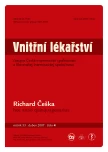Chronic pancreatitis – etiological classifications and diagnostic criteria
Authors:
Petr Dítě
Authors‘ workplace:
Interní gastroenterologická klinika Lékařské fakulty MU a FN Brno, pracoviště Bohunice, přednosta prof. MUDr. Petr Dítě, DrSc.
Published in:
Vnitř Lék 2007; 53(4): 354-358
Category:
Reviews
Overview
Current etiological classifications divide chronic pancreatitis into a toxo-nutritive form where the main agent is alcohol, and an idiopathic genetically induced form, an auto-immune form, and a recidivistic and obstructive form. It is clear that the different etiologies of the illness are associated with different histological findings. Knowledge of these is vitally important for targeted therapy and assessment of the progress of the disease. Even though chronic pancreatitis is still defined as a chronic, longstanding progressive process of fibrosis of the gland, it has been shown that precisely due to histological differences in the morphology of the gland, the chronic autoimmune form behaves completely differently during corticoid therapy than the alcohol- -induced form or the obstructive form. It seems that in the near future it will be necessary to change the definition of the illness as we know it today and change the existing algorithms for diagnosis and subsequent therapy.
Key words:
chronic pancreatitis – idiopathic form – autoimmune form
Sources
1. Dítě P, Starý K, Novotný I et al. Incidence of chronic pancreatitis in Czech republic. Europ J Gastroent Hepatol 2001; 13: 749-750.
2. Etemad B, Whitcomb DC. Chronic pancreatitis: Diagnosis, classification, and new genetic developments. Gastroenterology 2001; 120: 682-707.
3. Sarles H, Adler G, Dani R et al. The pancreatitis classification of Marseilles-Rome 1998. Scand J Gastroenterol 1989; 24: 641-642.
4. Sarner M, Cotton PB. Classification of pancreatitis. Gut 1984; 25: 756-759.
5. Singer MV, Gyr K, Sarles H. Revised classification of pancreatitis: Report of the Second international symposium on the classification of pancreatitis in Marseille, France, March 28-30 1984. Gastroenterology 1985; 89: 683-685.
6. Sarner M, Cotton PB. Definitions of acute and chronic pancreatitis. Clin Gastroenterol 1984; 13: 865-870.
7. Apte MV, Haber PS, Norton ID et al. Alcohol and the pancreas. Addict Biol 1998; 3: 137-150.
8. Layer P, Yamamoto H, Kalthoff L et al. The different courses of early- and late- onset idiopathic and alcoholic chronic pancreatitis. Gastroenterology 1994; 107: 1481-1487.
9. Lankisch PG. Natural course of chronic pancreatitis. Pancreatology 2001; 1: 3-14.
10. Yoshida K, Toki F, Takuchi T et al. Chronic pancreatitis caused by an autoimmune abnormality. Proposal of the concept of autoimmune pancreatitis. Dig Dis Sci 1995; 40: 1561-1568.
11. Sarles H, Sarles JC, Camatte R et al. Chronic inflammatory sclerosing of the pancreas - An autonomous pancreatic disease? Am J Dig Dis 1961; 6: 688-698.
12 Sahani DV. Autoimmune pancreatitis: imaging features. Radiology 2004; 233: 345-352.
13. Kim KP. Autoimmune chronic pancreatitis. Am J Gastroenterol 2004; 99: 1605-1616.
14. Okazaki K, Chiba T. Autoimmune related pancreatitis. Gut 2002; 51: 1-4.
15. Kamisawa T, Egawa N, Inokuma S et al. Morphological changes after steroid therapy in autoimmune pancreatitis. Scand J Gastroenterol 2004; 39: 1154-1158.
16. Horiuchi A, Kawa S, Akamatsu T et al. Characteristic pancreatic duct appearance in autoimmune chronic pancreatitis: A case report and review of the Japanese literature. Am J Gastroenterol 1998; 93: 200-263.
17. Ito T, Nakano I, Koyanagi S et al. Autoimmune pancreatitis as a new clinical entity: Three cases of autoimmune pancreatitis with effective steroid therapy. Dig Dis Sci 1997; 42: 1458-1468.
18. Kahl S, Glasbrenner B, Leodolter A et al. EUS in the diagnosis of early chronic pancreatitis: A prospective follow-up study. Gastrointest Endosc 2002; 55: 507-511.
19. Wallace MB, Hawes RH. Endoscopic ultrasound in the evaluation and treatment of chronic pancreatitis. Pancreas 2001; 23: 26-35.
20. Dítě P, Ševčíková A, Novotný I et al. Autoimune pancreatitis in Czech republic. - Czech and Slovak Gastroenterol and Hepatol 2007 (v tisku).
21. Otsuki M. Chronic pancreatitis. Pancreaology 2004; 4: 28-41.
22. Yagura M, Murai S, Kojima H et al. Changes of liver fibrosis in chronic hepatitis C patients with no response to interferon - alpha therapy: Including quantitative assessment by a morphometric method. J Gastroenterol 2000; 35: 105-111.
23. Shiratori Y, Imazeki F, Moriyama M et al. Histologic improvement of fibrosis in patients with hepatitis C who have sustained response to interferon therapy. Ann Intern Med 2000; 132: 517-524.
24. Kloppel G, Luttges J, Löhr M et al. Autoimmune pancreatitis: pathological, clinical and immunological features. Pancreas 2003; 27: 14-19.
25. Furukawa N, Muranaka T, Yasumori K et al. Autoimmune pancreatitis: Radiologic findings in three histologically proven cases. J Comput Assist Tomogr 1998; 22: 880-883.
26. Pitchumoni CS, Glasser M, Saran RM et al. Pancreatic fibrosis in chronic alcoholics and nonalcoholics without clinical pancreatitis. Am J Gastroenterol 1984; 79: 382-388.
27. Sica GT, Miller FH, Rodriguez G et al. Magnetic resonance imaging in patients with pancreatitis: Evaluation of signal intensity and enhancement changes. J Magn Reson Imaging 2002; 15: 275-284.
28. Novotný I. Endoskopická sonografie v diagnostice časné chronické pankreatitidy. Vnitř Lék 2000; 46: 704-708.
29. Lowenfels AB, Maisonneuve P, Cavallini G et al. Pancreatitis and the risk of pancreatic cancer: Intenational Pancreatitis Study Group. N Engl J Med 1993; 328: 1433-1437
30. Ekbom A, McLaughlin JK, Karlsson BM et al. Pancreatitis and pancreatic cancer: A population-based study. J Natl Cancer Inst 1994; 86: 625-627.
31. Talamini G, Falconi M, Bassi C et al. Incidence of cancer in the course of chronic pancreatitis. Am J Gastroenterol 1999; 94: 1253-1260.
32. Chari ST, Mohan V, Pitchumoni CS et al. Risk of pancreatic carcinoma in tropical calcifying pancreatitis: An epidemiologic study. Pancreas 1994; 9: 62-66.
Labels
Diabetology Endocrinology Internal medicineArticle was published in
Internal Medicine

2007 Issue 4
Most read in this issue
- Lipoprotein (a)
- How corticoids, growth hormone and oestrogens influence lipids and atherosclerosis
- Side effects of pharmacotherapy on lipid levels
- Can reduction in resting heart rate be beneficial for patients?
